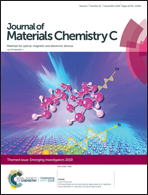D–A3 TADF emitters: the role of the density of states for achieving faster triplet harvesting rates†
Abstract
The triplet harvesting rate in purely organic materials based upon Thermally Activated Delayed Fluorescence (TADF) is critically important for achieving high performance Organic Light Emitting Diodes (OLEDs). One of the major challenges that must be overcome in these materials is the weak spin orbit coupling which can lead to triplet harvesting rates that extend into the millisecond range. This causes poor roll-off in device efficiency at higher current densities. In this work, we study the excited state properties of a new TADF design strategy based upon the D–A3 approach. Using TAT-3DBTO2, composed of a rigid triazatruxene donor core with three dibenzothiophene-S,S-dioxide peripheral acceptors, we explain how exploiting the high density of excited states and low lying conical intersections associated with this structure can achieve high-rates of triplet harvesting. However, we also demonstrate that excited state structural changes reduce the symmetry of the molecule and work against high triplet harvesting rates by causing localisation of the excited state electronic structure and non-equivalence between the acceptors. Consequently, the fast initial reverse intersystem crossing (rISC) channels are replaced by undesirable slower rISC channels. Our results imply that it will be possible to engineer molecules where undesirable decay pathways are removed giving new perspectives for designing functional TADF molecules.

- This article is part of the themed collection: Journal of Materials Chemistry C Emerging Investigators


 Please wait while we load your content...
Please wait while we load your content...